The results of a groundbreaking study show that a technology called spinal cord stimulation may benefit some patients previously diagnosed with permanent paralysis.
At the age of 23, Heather Rendulic suffered a stroke that left her with paralysis on the left side of her body. Even 10 years later, Rendulic’s left arm and hand remained immobile, making it impossible for her to tie her shoes, type with both hands, or cut her food independently.
However, in an extraordinary month after agreeing to participate in a breakthrough spinal cord stimulation study, Rendulic suddenly found herself able to unlock a lock with a key, draw a map of Italy, dip chicken into sauce, and eat with a fork—all using her left hand, which had been diagnosed with permanent paralysis.
“I can’t believe it. It’s as if I really have both hands back,” Rendulic said emotionally.
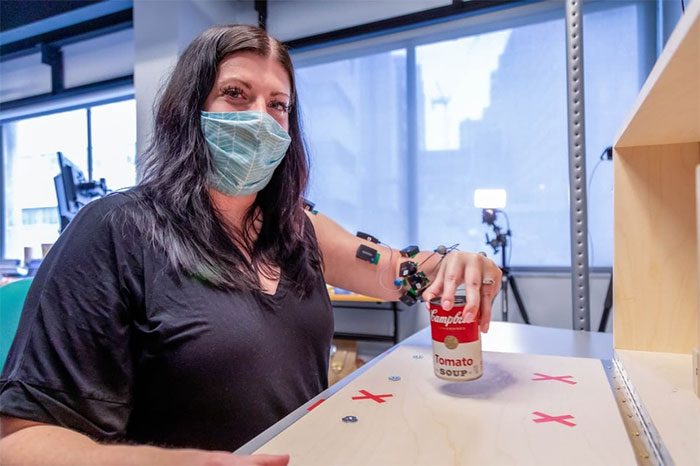
Heather Rendulic suffered a stroke at the age of 23, resulting in paralysis of her left arm and hand, making tasks like tying shoelaces impossible. Thanks to the new technology, Rendulic was able to use her left hand for the first time in 10 years. (Photo: UMPC).
This research was recently published in the journal Nature Medicine, marking the first successful demonstration that spinal cord stimulation technology can address muscle weakness and paralysis in the arms and hands of stroke patients.
A One-Handed Individual in a Two-Handed World
In December 2021, Heather Rendulic woke up with a tingling sensation on the left side of her body. She immediately went to the hospital, where doctors informed her that a blood vessel was bleeding near the base of her skull—a condition known as a cavernous malformation. At 22, Rendulic experienced her first stroke.
At that time, the blood vessel was buried too deep for doctors to proceed with surgery. Rendulic also believed she could continue living a normal life without surgery.
Many individuals with cavernous malformations remain stable for years and can lead normal lives. Unfortunately, Rendulic was not one of them. Over the next 11 months, she suffered five additional hemorrhages.
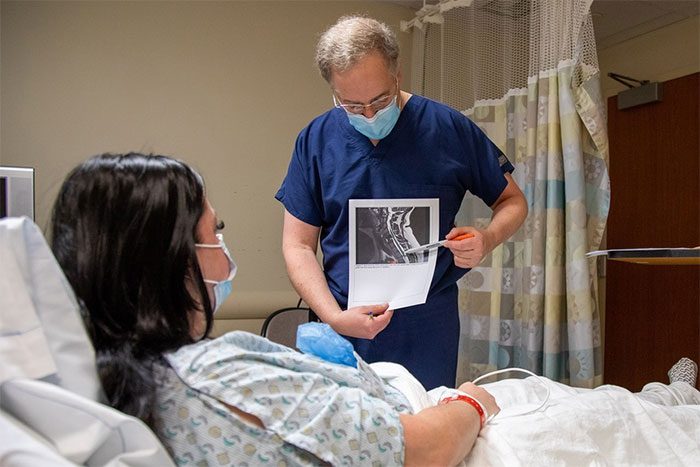
After a severe stroke, doctors had to perform brain surgery to remove the damage, but as a result, Rendulic’s arm and hand were nearly motionless. (Photo: UMPC).
The final incident was a severe stroke that left Rendulic paralyzed on the left side of her body. Doctors had to perform brain surgery to remove the damage, but as a result, Rendulic’s arm and hand were nearly immobile.
This event forced Rendulic to adjust her daily life. She had to use assistive devices in the kitchen to chop fruits and vegetables. Getting dressed became an extremely difficult challenge for her.
Meanwhile, tasks requiring fine motor skills, such as tying shoelaces or opening jars, were simply impossible for Rendulic.
“I had to live with one hand in a world where everyone around me used two hands,” said Rendulic, now 33. She felt exhausted relying on her husband to cut her steak.
According to Wired, stroke is the leading cause of paralysis in adults. Worldwide, on average, one in four people over 25 will experience a stroke in their lifetime. Among these, 75% will suffer from long-term loss of mobility in their arms and hands.
A stroke occurs when blood supply to the brain is blocked or when a blood vessel ruptures. Depending on the severity of the brain damage and its location, a stroke can cause various deficits, such as paralysis, weakness, or issues with speech, thinking, or memory.
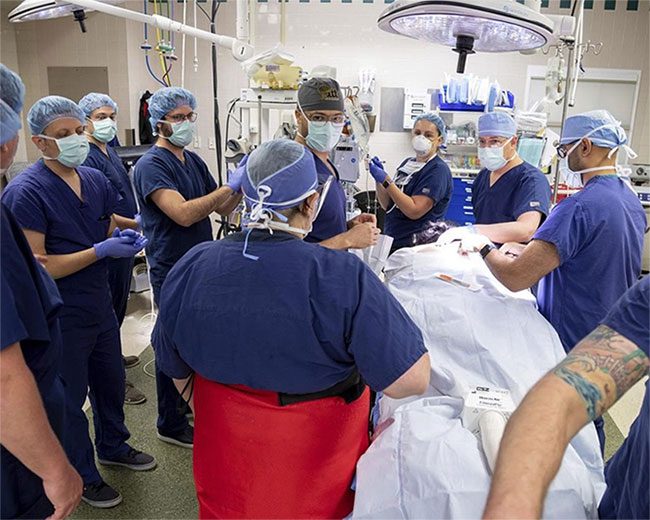
A stroke occurs when blood supply to the brain is blocked or when a blood vessel ruptures. Depending on the severity of the brain damage and its location, a stroke can lead to problems with speech, thinking, or memory. (Photo: UMPC).
Individuals paralyzed by a stroke cannot voluntarily move a muscle or group of muscles. When the part of the brain that controls movement is damaged, it interrupts the communication process between the brain and muscles.
However, thanks to a small study at the University of Pittsburgh exploring a type of electrical stimulation for the spinal cord, Rendulic was able to regain some of the movement in her hand and arm that she had lost over the past 10 years.
During the four-week trial, she and another patient were able to perform tasks such as raising their arms overhead, opening and closing their hands, using a fork and knife to eat, and for the first time, picking up small objects.
A “Wonder Drug” for Stroke Patients
To achieve this, researchers from the University of Pittsburgh and Carnegie Mellon University implanted electrodes along Rendulic’s spinal cord to create electrical stimulation while she was asked to perform these tasks.
Specifically, the surgeons implanted a pair of metal electrodes, as thin as spaghetti strands, along the upper region of the spinal cord in the neck, targeting the nerves that control the muscles of the arms and hands. The electrode cables were routed beneath the skin and connected to a stimulation system in the lab.
With electrical stimulation, Rendulic’s left arm became more agile, her fingers more dexterous, and she could perform intentional movements quickly and smoothly.
The moment the researchers activated the spinal stimulation device, Rendulic was able to fully open and grasp her left hand, something she had been unable to do before.
“We all cried. I was able to spread my hand, something I hadn’t done in nearly a decade,” Rendulic said, with her husband and mother witnessing the moment.
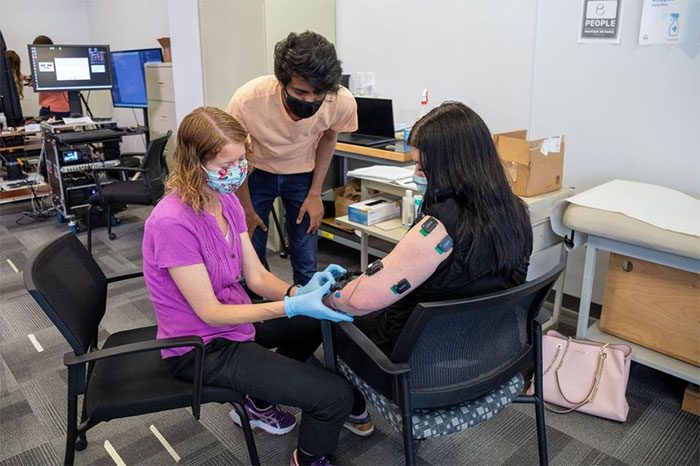
The surgeons implanted a pair of metal electrodes, as thin as spaghetti strands, along the upper region of the spinal cord in the neck to target the nerves that control the muscles of the arms and hands. (Photo: UPMC).
In fact, spinal stimulation technology has been used for decades to treat chronic pain.
More recently, experiments providing stimulation through surgically implanted electrodes or non-invasively via surface electrodes have shown promise in helping spinal cord injury patients regain mobility in their legs.
In some cases, they have even been able to move their arms and hands. Marco Capogrosso, an assistant professor of neurosurgery at the University of Pittsburgh, explained that this method is based on the fact that some nerve regions remain unharmed after a stroke.
“So, if we can develop this technology to amplify the neural signal, patients will have a chance to restore movement in their arms and hands,” Capogrosso explained.
During the four weeks of the trial, Rendulic was given increasingly difficult tasks, such as gripping and moving a can of soup.
In an experiment involving arranging objects in a box, when the electrical stimulation device was turned on, Heather scored 14 points. However, when the device was off, she could only achieve 6 points.
Reports noted that patients felt stimulation but did not experience pain, muscle stiffness, or safety issues.
The study was designed only to test the short-term effects of stimulation, so participants had to remove the device after the four-week trial period.
However, doctors were surprised that the patients in the study retained some improvement even after the stimulation was turned off.
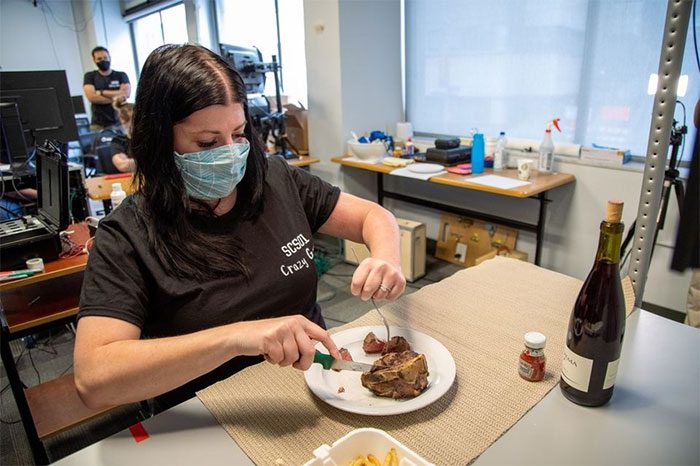
For the first time in 10 years, Rendulic was able to cut a piece of steak herself. (Photo: UPMC).
“We once thought that would be impossible after just four weeks of spinal stimulation,” said Dr. Elvira Pirondini, a co-author of the study.
Dr. Capogrosso acknowledged that it is still unclear exactly why the benefits may persist after turning off the device, but he hypothesized that “similar neural processes lead to movement recovery after the stimulation device is turned off.”
“We are not creating new nerve fibers, but I am certainly reinforcing the neural pathways that she preserved after her stroke,” Capogrosso added.
While offering hope for stroke-paralyzed patients, Dr. Daniel Lu, a neurosurgeon at the University of California, noted that the cost of this implant will prevent many patients from accessing it. Specifically, spinal stimulation devices currently range from $15,000 to $50,000.
Nevertheless, Rendulic immediately stated that she was willing to make a trade-off. She even threatened the doctors that she would not go to the hospital to allow them to retrieve the equipment. “I want to wear it for life. At least it has helped me cut my steak by myself, and that’s amazing,” Rendulic said.


















































